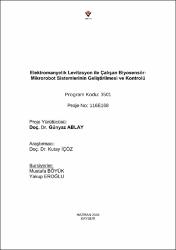| dc.contributor.author | Ablay, Gunyaz | |
| dc.contributor.author | İçöz, Kutay | |
| dc.date.accessioned | 2024-03-15T08:51:05Z | |
| dc.date.available | 2024-03-15T08:51:05Z | |
| dc.date.issued | 2020 | en_US |
| dc.identifier.uri | https://hdl.handle.net/20.500.12573/1999 | |
| dc.description.abstract | Bu arastırma mikron seviyesinde hareket etme yetenegine sahip manyetik levitasyon ile çalısan biyosensör-mikrorobot tasarımını gerçeklestirmeye çalısmaktadır. Manyetik levitasyon teknigi, mikro/nano manyetik parçacıklar ile kuvvetlendirilmis veya paramanyetik bir ortama serpilmis biyolojik varlıkların (tümör hücresi gibi) tespitinde veya analizinde kullanılabilir. Benzer mantıkla, kontrollü manyetik levitasyon ile mikro-manyetik parçacıklar içeren mikrorobotlar gelistirilerek mikron seviyesindeki tekrarlanan çesitli görevlerin otomatik bir sekilde yapılması saglanabilir. Manyetik levitasyon tahrik sistemleri biyolojik ortamlarda zararsızdır, nahos ortam sartlarında çalısabilmektedir ve sürtünmenin etkisini minimize edebilme özelligine sahiptir. Mikrorobot teknolojisi ile minyatür parçalar belli bir hedef noktaya tasınabilir ve nahos/tehlikeli ortamlarda kurulabilirler. Bu proje, etkin ve otomatik mikro-parçacık manipülasyonu için geribeslemeli kontrol yapılarından olusan ve yatay eksende bir ve iki boyutlu manipülasyon imkanı saglayan bir elektromanyetik aktüatör tabanlı manyetik mikromanipülatör tasarımı ve uygulaması üzerine yapılmıstır. Elektromıknatıs tasarımında, uygulanan kontrol akımı ve elektromıknatıs konfigürasyonu manyetik kuvvet ve tork degerlerini belirlemektedir ve bundan dolayı en uygun, kuvvetli ve hassas bir tasarım için uygun nüve yapılarıyla beraber geribeslemeli kontrol mekanizmasının gelistirilmesine ihtiyaç vardır. Manyetik aktüatörlerin, 1 ila 10 ?m çaplı süperparamanyetik parçacık üzerinde yaklasık olarak 1 ila 25 pN kuvvet üretmesi amaçlanmıstır. Bunun için 6-8 mm boyundaki koni sekilli uca sahip nikel-demir alasımlı nüve ve 2000 bakır sarımından yapılmıs bir, iki ve dört elektromıknatıstan olusan konfigürasyonlar elde edildi. Manyetik mikromanipülatör, ilk prensipler yoluyla modellendi ve bu model yardımıyla iki farklı kontrol metodu önerildi. Ilk kontrolör ofset akım tabanlı lineer kontrolör olup modeldeki lineer olmayan terimleri dogrusallastırabilme özelligine sahiptir. Ikinci kontrolör ise integral geriadımlama tabanlı nonlineer bir kontrolör olup yumusak ve etkin kontrol akımları üretebilmektedir. Tasarlanan kontrolörlerin bir boyutta ve 2-boyutta sistemin kapalı çevrimli dinamigini kararlı hale getirdigi, hızlı geçici rejim yanıtı verdigi ve sıfır kararlı durum hatası verdigi deneysel çalısmalarla gösterilmistir. Tasarlanan elektromanyetik mikromanipülatör özellikle biyolojik ayrıstırma, tıp ve biyosensör gelistirilmesi gibi alanlarda kullanılabilecek genis bir kuvvet aralıgında çalısabilme kapasitesine sahiptir. | en_US |
| dc.description.abstract | This research will entail design of magnetically levitated biosensors and microrobots that are
capable of micron-level motions. Magnetic levitation method can be used for detection or
analysis of biological properties (like tumor cells) that are strengthened with micro/nano
magnetic particles or are scattered in a paramagnetic environment. With a similar point of view,
microrobots composed of micro-magnetic pieces may be developed to carry out various
repeatable micron-level motions with a controlled magnetic levitation. The magnetically
levitated actuation systems are harmless in biological environments, can function in harsh
environments, and can minimize friction effects and the associated problems of fine particle
matter generation. With the microrobot technology, it is possible to move small particles to a
certain targeted place and to set up in a dirty/hazardous medium.
This project was carried out on the design and application of an electromagnetic actuator
based magnetic micromanipulator which consists of feedback control structures for effective
and automatic micro-particle manipulation, and provides one and two-dimensional
manipulation on the horizontal axis. In the design of the electromagnet, the applied control
current and the magnet configuration determine the magnetic force and torque values, and
therefore there is a need to develop the feedback control mechanism with the appropriate core
structures for an optimal, strong and precise design. The magnetic actuators are intended to
produce approximately 1 to 25 pN of force on the 1 to 10 μm diameter superparamagnetic
particle. For this purpose, several configurations with one, two and four electromagnets
consisting of nickel-iron alloy core having 6-to-8 mm long cone shaped tip and four
electromagnet made from 2000 copper coil have been obtained. The magnetic
micromanipulator is modeled by the first principles and two different controllers are proposed
with the help of this model. The first controller is an offset current based linear controller which
has feature of linearizing nonlinear terms in the model. The second controller is an integral
backstepping based nonlinear controller which produces smooth and effective control currents.
It is shown by experimental studies that the designed controllers stabilize the closed-loop
dynamics of the system, give a fast transient response and a zero steady-state error. The
designed electromagnetic micromanipulator has the capacity to operate in a wide range of
fields, especially in biological separation, medicine and biosensor development. | en_US |
| dc.language.iso | tur | en_US |
| dc.publisher | TUBİTAK | en_US |
| dc.rights | info:eu-repo/semantics/openAccess | en_US |
| dc.subject | mikromanipülatör | en_US |
| dc.subject | mikrorobot | en_US |
| dc.subject | manyetik levitasyon | en_US |
| dc.subject | biyosensör | en_US |
| dc.subject | lineer kontrol | en_US |
| dc.subject | nonlineer kontrol | en_US |
| dc.title | Elektromanyetik Levitasyon ile Çalışan Biyosensör- Mikrorobot Sistemlerinin Geliştirilmesi ve Kontrolü | en_US |
| dc.type | project | en_US |
| dc.contributor.department | AGÜ, Mühendislik Fakültesi, Elektrik - Elektronik Mühendisliği Bölümü | en_US |
| dc.contributor.authorID | 0000-0003-2862-6761 | en_US |
| dc.contributor.authorID | 0000-0002-0947-6166 | en_US |
| dc.contributor.institutionauthor | Ablay, Günyaz | |
| dc.contributor.institutionauthor | İçöz, Kutay | |
| dc.identifier.startpage | 1 | en_US |
| dc.identifier.endpage | 70 | en_US |
| dc.relation.journal | Tubitak | en_US |
| dc.relation.tubitak | 116E168 | |
| dc.relation.publicationcategory | Diğer | en_US |


















